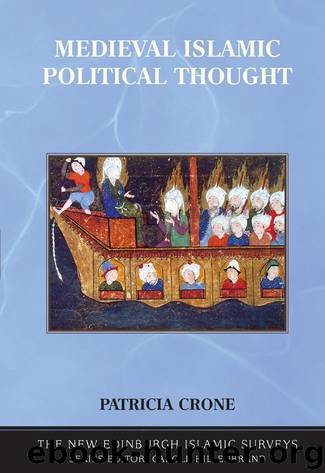Medieval Islamic Political Thought (New Edinburgh Islamic Surveys) by Patricia Crone

Author:Patricia Crone [Crone, Patricia]
Language: eng
Format: epub, mobi
Publisher: Edinburgh University Press
Published: 2014-03-11T00:00:00+00:00
Caliph and sultan
Al-Ghazālī’s caliph had a novel feature in that he was not meant to rule his followers in political terms. Unlike the Ismailis, or for that matter his teacher, al-Ghazālī acknowledged that the Muslims now belonged to two different communities, one religious and the other political, one the umma and the other the secular kingdoms into which it was divided. The umma had been founded by the Prophet on the basis of his law and was still headed by one of his descendants: this was the community of believers or congregation to which all Muslims (as seen by al-Ghazālī) belonged, the Sunni version of the catholic (all-embracing, ‘big-tent’) church; and this was the community that the caliph represented. But as subjects the Muslims were now distributed in ephemeral kingdoms headed by profane rulers, to whom they paid their taxes and on whose armies they relied for such security as they had. This was the community or communities (regna in medieval European parlance) represented by the sultan(s). Al-Ghazālī would clearly have preferred to live without this duality, but unlike his teacher, he saw that it had come to stay. Al-Juwaynī had still thought of the imam as the leader of a community that was both political and religious: it was for this reason that he wanted to replace the titular caliph with a real ruler. The Ismailis also thought of the imam as the head of a community that was both political and religious: what they wanted was a rightly guided imam in charge of both spheres. Al-Juwaynī’s solution amounted to secularization of the community of believers, while that of the Ismailis left the Turkish invaders out of the picture, or alternatively required their military power to be sanctified. Al-Ghazālī found the only solution to lie in a division of labour.
The division of labour proposed by al-Ghazālī was quite simple: the secular ruler supplied the power, the caliph supplied the moral purpose for which power was to be used. Differently put, the caliph was now head of the religious community alone. This was the only community to matter in moral terms, for unlike the ephemeral kingdoms into which it was divided from time to time, it was the community in which one travelled to eternal salvation. But it lacked military power. The imam needed such power (shawka), al-Ghazālī said, so he had to collaborate with a secular ruler or, as he terms it, a strongman (dhū shawka), who would set him up. If there was a single powerful man commanding general obedience, the candidate became imam by virtue of receiving allegiance from him. If there were several, they would have to come to an agreement and the same would apply. The key point was that the military ruler or rulers should lend their power to the imam, by undertaking to serve as his executives.119
Al-Ghazālī calls this undertaking tafwīḍ, delegation,120 a startling term in that it acknowledges upfront that the power came from outside the religious institution. The term is more
Download
Medieval Islamic Political Thought (New Edinburgh Islamic Surveys) by Patricia Crone.mobi
This site does not store any files on its server. We only index and link to content provided by other sites. Please contact the content providers to delete copyright contents if any and email us, we'll remove relevant links or contents immediately.
The Leavers by Lisa Ko(6473)
Born to Run: by Christopher McDougall(6260)
iGen by Jean M. Twenge(4702)
Sapiens by Yuval Noah Harari(4537)
The Kite Runner by Khaled Hosseini(4435)
Spare by Prince Harry The Duke of Sussex(4195)
Bullshit Jobs by David Graeber(3179)
Livewired by David Eagleman(3121)
Goodbye Paradise(2962)
Never by Ken Follett(2880)
A Dictionary of Sociology by Unknown(2518)
Harry Potter 4 - Harry Potter and The Goblet of Fire by J.K.Rowling(2416)
The Club by A.L. Brooks(2360)
People of the Earth: An Introduction to World Prehistory by Dr. Brian Fagan & Nadia Durrani(2346)
The Social Psychology of Inequality by Unknown(2310)
Machine Learning at Scale with H2O by Gregory Keys | David Whiting(2290)
Harry Potter and the Order of the Phoenix (5) by J.K. Rowling(2227)
0041152001443424520 .pdf by Unknown(2220)
Don't Sleep, There Are Snakes by Daniel L. Everett(2216)
